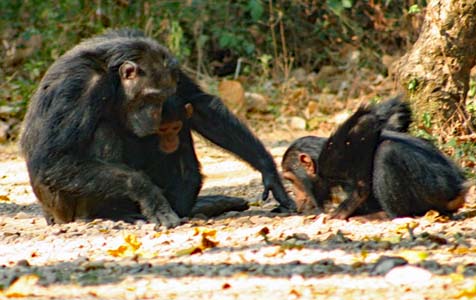Chimpanzee Adolescence and Gender Specific Roles

Credit- Eric Matthews
With early adolescence,
8-12 years of age in males and 8-10 years of age in
females, chimpanzees begin to show significant differences
in their behavior. Males spend more time with adult males
patrolling the perimeters of their home territory, to
detect and pursue chimpanzees of other communities.
Females remain close to their mothers and begin to show
adolescent swellings that signal the reproductive status
of the female to males. Young females learn to be mothers
by watching their mother and helping her with younger
siblings.
At 13-15 years of age,
late adolescent male chimpanzees spend most of their time
with adult males and females in estrus (sexually
receptive), remaining peripheral to the main body of the
community. During this period of time, young males attain
dominance over all females. Late adolescent chimpanzees,
11-13 or 14 years of age, begins with the onset of estrus
cycles and adolescent sterility and ends with females
being able to successfully reproduce. Consortships, the
distancing of a male and female from the group for sexual
privileges, first occur at this time. Some females
transfer to another community for a brief period of time,
and reproduce with males in that community. Returning
females are often pregnant or carrying an infant.
Chimpanzees are mature
at 16-20 years of age. Old age begins at 33 years of age
in the wild. We now know wild chimpanzees live to be much
older than first thought. Wild chimpanzees may live to be
40 or 50 years old or more.
Captive Chimpanzees
Just like wild
chimpanzees, young chimpanzees living in zoos must learn
to be mothers and leaders from observing and interacting
with members of their family and social group. However,
chimpanzees mature earlier in captivity and live longer
lives. Old chimpanzees continue to contribute to the
community. They are caregivers for the young, respected
members of the political hierarchy, and often keep peace
among the group members or act to restore group harmony
after an act of aggression.

